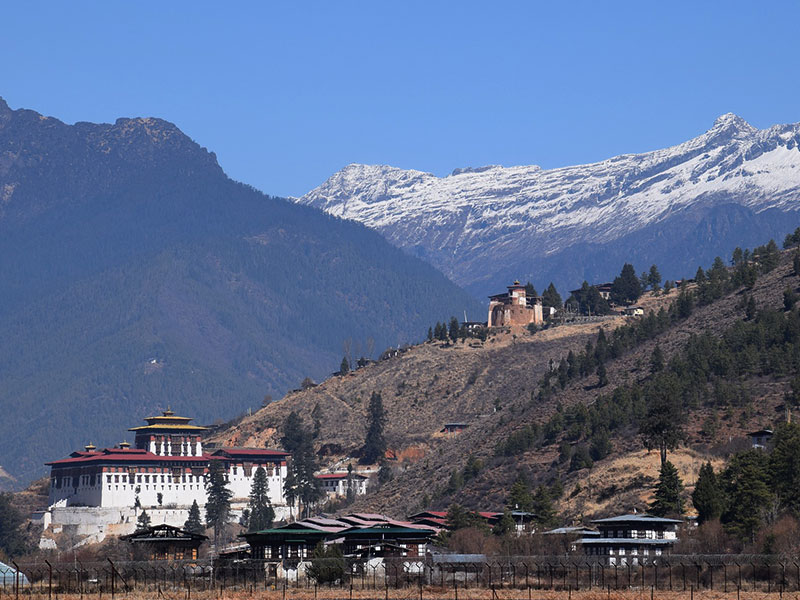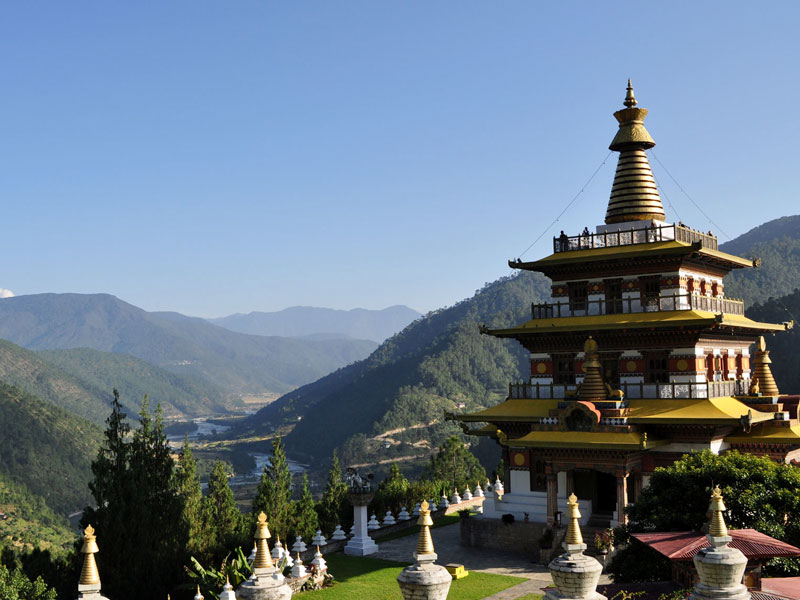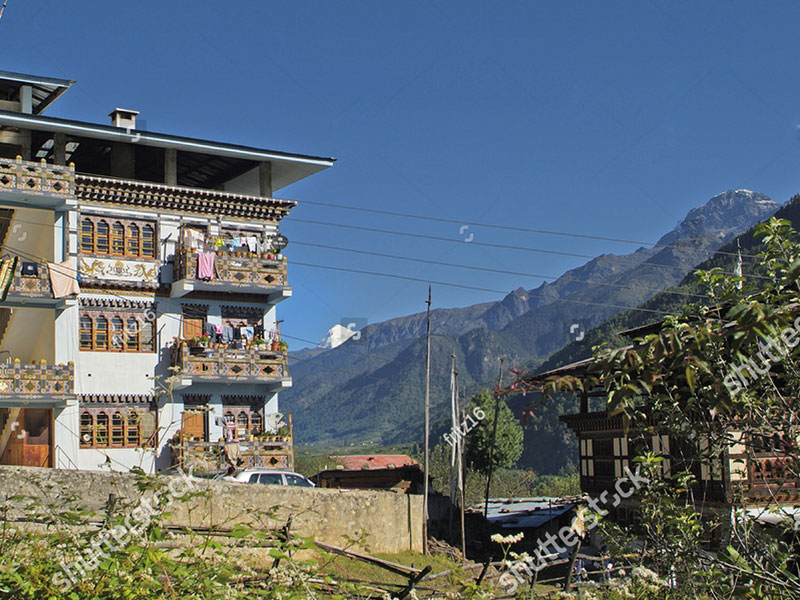
Cultural Tours - 7 nights and 8 days

Cultural Tours - 7 nights and 8 days
-
What is included
- Accommodation on twin sharing/double occupancy with breakfast
- Lunch and Dinner at selected local restaurants
- Government approved required category hotels on twin sharing basis.
- All airport pickups and drops in Paro.
- Ground transport in comfortable private vehicle in Bhutan during the tour.
- Experienced English speaking guides and local staff during the tour.
- All city tour with permits and entrance fees for museums and monuments.
- All government taxes.
- Bhutan Visa fee.
- Our service charges.
What is not included
- Airfare to/from Paro, Bhutan (Quoted separately)
- Items of a personal nature (personal gear,telephone calls,beverages,internet,laundry etc).
- Trip cancellation and Medical/Evacuation Insurance.
- Tips for Staff (guide and driver).
Trip Notes
Download the detailed trip notes for everything you could possibly want to know about this trip, including detailed itinerary and full kit list.
View Trip NotesDifficulty Level

Moderate
Half- to full-day hikes (3-6 hours) over rolling countryside on most days, occasional steep trails. Many of our hotel-based walking tours are in this category, as are our snorkeling adventures.
-
Detailed Itinerary
-
Day 01
Arrival in Paro and drive to Thimpu
On arrival at Paro international airport you will be received by our representative and transfer to Thimphu by private car. Check into your hotel. Delicious lunch will be served at your hotel and afternoon we will proceed for city sightseeing.
Visit Memorial chorten, stupa built in the memory of our late 3rd king.
This large impressive monument with its golden spire was built in 1974 to honour the memory of the third King, His Majesty Jigme Dorji Wangchuck (1928 – 1972).Built by his mother Her Majesty the late Queen Ashi Phuntsho Choden Wangchuck, the whitewashed chorten is decorated with richly carved annexes facing the four directions, and features elaborate mandalas, statues and a shrine dedicated to the popular third king. There are numerous religious paintings and complex tantric statues housed inside reflecting both peaceful and wrathful aspects of Buddhist deities.
The memorial chorten, with its sun-catching golden finial, is one of the most visible religious structures in Thimphu, and for many people it is the focus of their daily worship. Throughout the day people circumambulate the chorten, whirl the large red prayer wheels and pray in the adjacent shrine. The early morning is particularly tranquil as elderly people shuffle in and spruced-up kids on their way to school whiz in and out to pay homage.Visit the massive statue of Shakyamuni measures in at a height of 51.5 meters, making it one of the largest statues of Buddha in the world. The statue is made of bronze and is gilded in gold. 125,000 smaller Buddha statues have been placed within the Buddha Dordenma statue, 100,000 8 inch tall and 25,000 12 inch tall statues respectively. Each of these thousands of Buddhas have also been cast in bronze and gilded. The throne that the Buddha Dordenma sits upon is a large meditation hall. The Buddha Dordenma is located atop a hill in Kuenselphodrang Nature Park and overlooks the Southern entrance to Thimphu Valley. The statue fulfills an ancient prophecy dating back to the 8th century A.D that was discovered by Terton Pema Lingpa (Religious Treasure Discoverer) and is said to emanate an aura of peace and happiness to the entire world.Places: Thimpu -
Day 02
Thimpu Sightseeing
After our leisurely breakfast we will start our day visiting handmade paper factory, visit painting school, nearby folk heritage museum and national library. Lunch in the town, after lunch.
Trashichhodzong: This impressive fortress/monastery houses Secretariat building, the throne room of His Majesty, the King and various government offices. It is also the summer residence of Chief Abbot and central monk body. Then, visit the government-run Handicrafts Emporium and local crafts shops, to browse through example of Bhutan's fine traditional arts. Here you can buy hand-woven textiles, thangkha paintings, masks, ceramics, slate and wood carvings, jewelry, interesting items made from local materials. Later leisure time at the hotel.Places: Thimpu -
Day 03
Thimpu to Gangtey
Today we head for Gangtey, about 150 kilometers away from Thimphu. En route, stop at Dochula Pass where you will have a coffee break while appreciating the striking view of Mt. Himalaya. You will also visit the grand 108 stupas. After that, we continue driving to Gangtey. It is a beautiful and tranquil place surrounded by lush forests. This evening remains free for you. If you are interested, you can stroll around the Gangtey Valley and pay a visit to the exquisite Gangtey Goempo.Places: Gangtey -
Day 04
Gangtey to Punakha
Today drive back to Punakha, on the way hike to ChhimeLhakhang, lies on the periphery of the expansive valley of Lobesa where the borders of Thimphu, Punakha and Wangduephodrang districts meets. Perched on top of a little hilltop overlooking the Puna Tsang Chhu. It is widely known today that most of the thousands of people who visit the lhakhag do so to pray for children either to ask for children by those who are childless or to seek protection for children that they already have. While ChhimeLhakhang is renowned for its fertility blessings, it also fulfils the other religious and spiritual needs of the people. After lunch visit Punakha Dzong. ZhabdrungNgawangNamgyel, the founder of Bhutanese state, built PunakhaDzong in 1637. It was originally named PuntangDechenPhodrangDzong, which means the Palace of Great Bliss. Punakha Dong was built on the 8th day and 8th month of the Fire ox year in 1673. The Tibetan attacked the dzong in 1639 and 1644. The defenders successfully repelled the attacks. To commemorate the victory, a New Year festival was introduced and Yu GyalGonkhang Chen Mo, "the great shrine of the protective and victorious lord" was built. The first King of modern Bhutan was crowned in PunakhaDzong. PunakhaDzong remained the centre of government until it was relocated to Thimphu. In 2011, the wedding of the 5th King was held in this fortress.Places: Punakha -
Day 05
Punakha
Meals: BBAfter breakfast hike KhamsumYulleyNamgyalChorten stands out on a beautiful ridge above the Punakha valley. Her Majesty built the Queen Mother, AshiTsheringYangdonWangchuck it. It took 9 years to build and Holy Scriptures rather than engineering manuals were consulted to construct this 4-storey temple. It is a fine example of Bhutanese architecture and artistic traditions. This temple has been dedicated for the wellbeing of the kingdom, its people and all sentient beings. It is a 30mins hike from the suspension bridge.The Chorten would take a one-hour hike to approach. It offers a beautiful view of the Punakha Valley. After lunch walk across the suspension bridge through absolutely fresh breeze and fascinating view of Dzong. Folow the farm houses gradually climbing towards Dompala hills. The view of Dzong , Pho chhu, Mo chhu(rivers) and surrounding village is superb amidst chirpine forest. The climb is another two and half hours to Limbukha. Limbukha farmers grow Bhutan’s Famous red rice which is supposed to have medicinal values. This particular rice needs clean mountain spring so that the taste is good and nutritional values.Meals: BBPlaces: Punakha -
Day 06
Punakha to Paro
Transfer to Paro . Afternoon visit Ta Dzong, inaugurated as National Museum in 1968, and holding a fascinating collection. After that walk down the trail to visit Rinpung Dzong, also known as "fortress of the heap of jewels". Built in 1646 by Shabdrung Ngawang Namgyal , the first spiritual and temporal ruler of Bhutan. Evening visit Kyichu Lhakhang, built in 7th century, is one of the two oldest and most sacred shrines in Bhutan (ther other being Jambay Lhakahng in Bumthang).Places: Paro -
Day 07
Paro
Embark on a long hike to one of Bhutan’s most revered icons, Taktsang (also known as Tiger’s Nest Monastery), perched 3,000 feet above the valley floor. Far from being a monument, it is a living, breathing monastery, home to a handful of monks. Hang a prayer flag to send Buddhist blessings via the winds. Afterward, enjoy a lunch overlooking Taktsang. After lunch visit the ruins of DrukgyelDzong. It was from here that the Bhutanese repelled several Tibetan armies during the 17th century. The Drukgyel Dzong in Paro was built in 1649 to commemorate the victory of the Bhutanese over the allied Tibet-Mongol forces. Drukgyel means ‘the fortress of victory’. A fire caused in 1951 completely destroyed the Dzong, what now remains are tokens of a haunted house, still robust walls and charred remains of gigantic wooden posts and beams.Places: Paro -
Day 08
Departure.
Trip Notes
Download the detailed trip notes for everything you could possibly want to know about this trip, including detailed itinerary and full kit list.
View Trip Notes -
-
Accommodation
Trip Notes
Download the detailed trip notes for everything you could possibly want to know about this trip, including detailed itinerary and full kit list.
View Trip Notes -
Make This Tour Private
Want to make it a private tour ?
Book this trip as a private departure - for any group, big or small.
-
Write a Review
-
Overview
What is included
- Accommodation on twin sharing/double occupancy with breakfast
- Lunch and Dinner at selected local restaurants
- Government approved required category hotels on twin sharing basis.
- All airport pickups and drops in Paro.
- Ground transport in comfortable private vehicle in Bhutan during the tour.
- Experienced English speaking guides and local staff during the tour.
- All city tour with permits and entrance fees for museums and monuments.
- All government taxes.
- Bhutan Visa fee.
- Our service charges.
What is not included
- Airfare to/from Paro, Bhutan (Quoted separately)
- Items of a personal nature (personal gear,telephone calls,beverages,internet,laundry etc).
- Trip cancellation and Medical/Evacuation Insurance.
- Tips for Staff (guide and driver).
-
Detailed Itinerary
Day 01 : Arrival in Paro and drive to Thimpu
On arrival at Paro international airport you will be received by our representative and transfer to Thimphu by private car. Check into your hotel. Delicious lunch will be served at your hotel and afternoon we will proceed for city sightseeing.
Visit Memorial chorten, stupa built in the memory of our late 3rd king.
This large impressive monument with its golden spire was built in 1974 to honour the memory of the third King, His Majesty Jigme Dorji Wangchuck (1928 – 1972).Built by his mother Her Majesty the late Queen Ashi Phuntsho Choden Wangchuck, the whitewashed chorten is decorated with richly carved annexes facing the four directions, and features elaborate mandalas, statues and a shrine dedicated to the popular third king. There are numerous religious paintings and complex tantric statues housed inside reflecting both peaceful and wrathful aspects of Buddhist deities.
The memorial chorten, with its sun-catching golden finial, is one of the most visible religious structures in Thimphu, and for many people it is the focus of their daily worship. Throughout the day people circumambulate the chorten, whirl the large red prayer wheels and pray in the adjacent shrine. The early morning is particularly tranquil as elderly people shuffle in and spruced-up kids on their way to school whiz in and out to pay homage.Visit the massive statue of Shakyamuni measures in at a height of 51.5 meters, making it one of the largest statues of Buddha in the world. The statue is made of bronze and is gilded in gold. 125,000 smaller Buddha statues have been placed within the Buddha Dordenma statue, 100,000 8 inch tall and 25,000 12 inch tall statues respectively. Each of these thousands of Buddhas have also been cast in bronze and gilded. The throne that the Buddha Dordenma sits upon is a large meditation hall. The Buddha Dordenma is located atop a hill in Kuenselphodrang Nature Park and overlooks the Southern entrance to Thimphu Valley. The statue fulfills an ancient prophecy dating back to the 8th century A.D that was discovered by Terton Pema Lingpa (Religious Treasure Discoverer) and is said to emanate an aura of peace and happiness to the entire world.Places: ThimpuDay 02 : Thimpu Sightseeing
After our leisurely breakfast we will start our day visiting handmade paper factory, visit painting school, nearby folk heritage museum and national library. Lunch in the town, after lunch.
Trashichhodzong: This impressive fortress/monastery houses Secretariat building, the throne room of His Majesty, the King and various government offices. It is also the summer residence of Chief Abbot and central monk body. Then, visit the government-run Handicrafts Emporium and local crafts shops, to browse through example of Bhutan's fine traditional arts. Here you can buy hand-woven textiles, thangkha paintings, masks, ceramics, slate and wood carvings, jewelry, interesting items made from local materials. Later leisure time at the hotel.Places: ThimpuDay 03 : Thimpu to Gangtey
Today we head for Gangtey, about 150 kilometers away from Thimphu. En route, stop at Dochula Pass where you will have a coffee break while appreciating the striking view of Mt. Himalaya. You will also visit the grand 108 stupas. After that, we continue driving to Gangtey. It is a beautiful and tranquil place surrounded by lush forests. This evening remains free for you. If you are interested, you can stroll around the Gangtey Valley and pay a visit to the exquisite Gangtey Goempo.Places: GangteyDay 04 : Gangtey to Punakha
Today drive back to Punakha, on the way hike to ChhimeLhakhang, lies on the periphery of the expansive valley of Lobesa where the borders of Thimphu, Punakha and Wangduephodrang districts meets. Perched on top of a little hilltop overlooking the Puna Tsang Chhu. It is widely known today that most of the thousands of people who visit the lhakhag do so to pray for children either to ask for children by those who are childless or to seek protection for children that they already have. While ChhimeLhakhang is renowned for its fertility blessings, it also fulfils the other religious and spiritual needs of the people. After lunch visit Punakha Dzong. ZhabdrungNgawangNamgyel, the founder of Bhutanese state, built PunakhaDzong in 1637. It was originally named PuntangDechenPhodrangDzong, which means the Palace of Great Bliss. Punakha Dong was built on the 8th day and 8th month of the Fire ox year in 1673. The Tibetan attacked the dzong in 1639 and 1644. The defenders successfully repelled the attacks. To commemorate the victory, a New Year festival was introduced and Yu GyalGonkhang Chen Mo, "the great shrine of the protective and victorious lord" was built. The first King of modern Bhutan was crowned in PunakhaDzong. PunakhaDzong remained the centre of government until it was relocated to Thimphu. In 2011, the wedding of the 5th King was held in this fortress.Places: PunakhaDay 05 : Punakha
After breakfast hike KhamsumYulleyNamgyalChorten stands out on a beautiful ridge above the Punakha valley. Her Majesty built the Queen Mother, AshiTsheringYangdonWangchuck it. It took 9 years to build and Holy Scriptures rather than engineering manuals were consulted to construct this 4-storey temple. It is a fine example of Bhutanese architecture and artistic traditions. This temple has been dedicated for the wellbeing of the kingdom, its people and all sentient beings. It is a 30mins hike from the suspension bridge.The Chorten would take a one-hour hike to approach. It offers a beautiful view of the Punakha Valley. After lunch walk across the suspension bridge through absolutely fresh breeze and fascinating view of Dzong. Folow the farm houses gradually climbing towards Dompala hills. The view of Dzong , Pho chhu, Mo chhu(rivers) and surrounding village is superb amidst chirpine forest. The climb is another two and half hours to Limbukha. Limbukha farmers grow Bhutan’s Famous red rice which is supposed to have medicinal values. This particular rice needs clean mountain spring so that the taste is good and nutritional values.Meals: BBPlaces: PunakhaDay 06 : Punakha to Paro
Transfer to Paro . Afternoon visit Ta Dzong, inaugurated as National Museum in 1968, and holding a fascinating collection. After that walk down the trail to visit Rinpung Dzong, also known as "fortress of the heap of jewels". Built in 1646 by Shabdrung Ngawang Namgyal , the first spiritual and temporal ruler of Bhutan. Evening visit Kyichu Lhakhang, built in 7th century, is one of the two oldest and most sacred shrines in Bhutan (ther other being Jambay Lhakahng in Bumthang).Places: ParoDay 07 : Paro
Embark on a long hike to one of Bhutan’s most revered icons, Taktsang (also known as Tiger’s Nest Monastery), perched 3,000 feet above the valley floor. Far from being a monument, it is a living, breathing monastery, home to a handful of monks. Hang a prayer flag to send Buddhist blessings via the winds. Afterward, enjoy a lunch overlooking Taktsang. After lunch visit the ruins of DrukgyelDzong. It was from here that the Bhutanese repelled several Tibetan armies during the 17th century. The Drukgyel Dzong in Paro was built in 1649 to commemorate the victory of the Bhutanese over the allied Tibet-Mongol forces. Drukgyel means ‘the fortress of victory’. A fire caused in 1951 completely destroyed the Dzong, what now remains are tokens of a haunted house, still robust walls and charred remains of gigantic wooden posts and beams.Places: ParoDay 08 : Departure.
-
Essential Info
-
Accommodation
-
Gallery
Difficulty Level
Moderate
Half- to full-day hikes (3-6 hours) over rolling countryside on most days, occasional steep trails. Many of our hotel-based walking tours are in this category, as are our snorkeling adventures.
Trip Notes
Download the detailed trip notes for everything you could possibly want to know about this trip, including detailed itinerary and full kit list.
View Trip Notes






